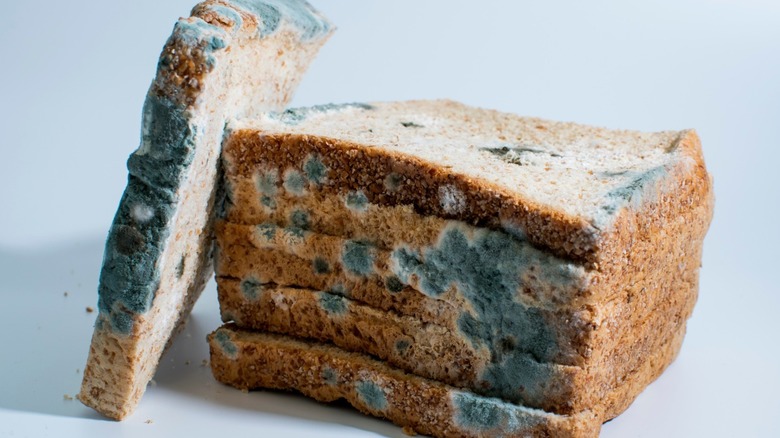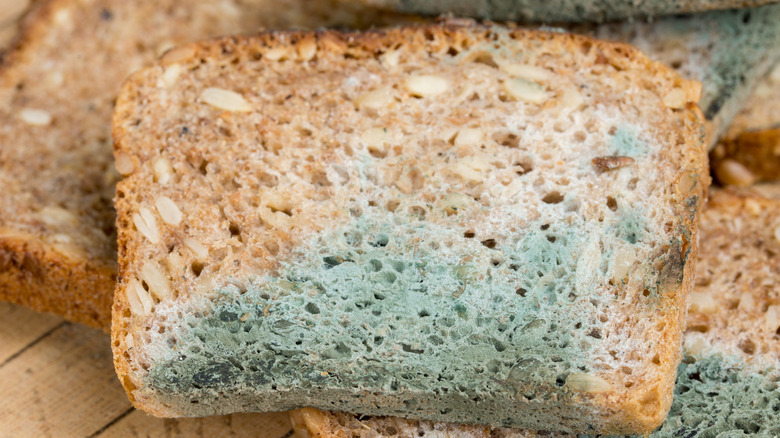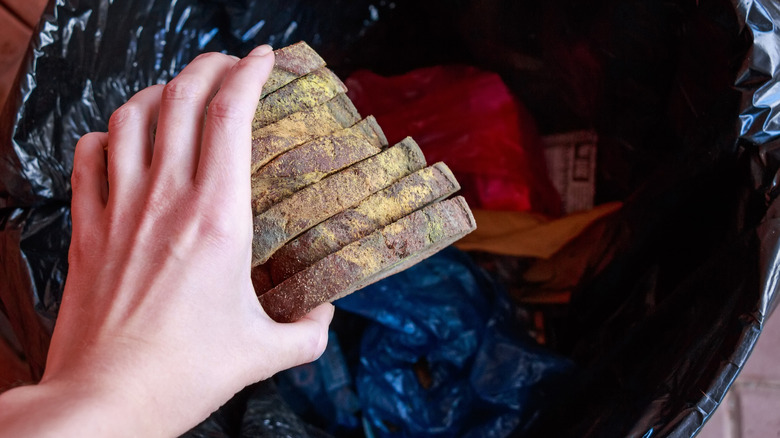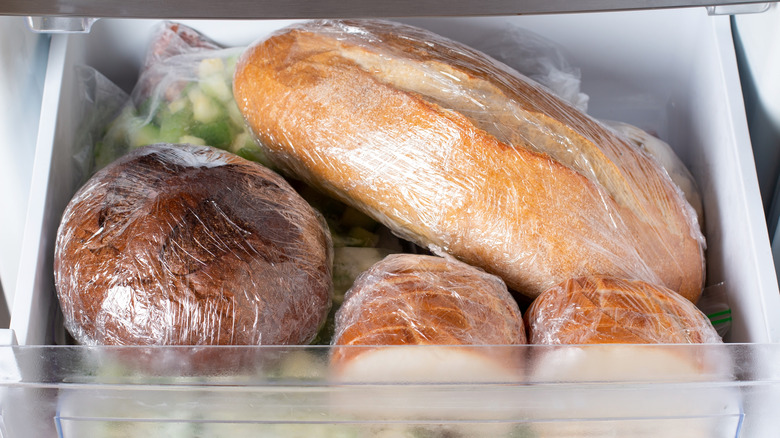Why You Shouldn't Just Cut The Mold Off Old Bread
Mold is an interesting — and confusing — part of what we eat. It makes most foods inedible but makes certain other foods taste so good. According to What's Cooking America, mold is formed by millions of tiny fungi organisms in the air that settle on surfaces of food. They grow there, forming fuzzy patches of white, grey, greenish-blue, or black mold that becomes larger as time passes.
Although some forms of mold are safely used by cheesemongers to create flavorful blue-veined or white rind cheeses, the mold that forms on foods in our home — on leftovers, bread, meats, and jams — creates toxins that can make you sick if eaten or inhaled.
If you encounter unexpectedly moldy food, you might wonder if you can just slice those fuzzy patches off and salvage the rest. (Food has gotten expensive, after all, and it's such a waste when it has to be tossed.) And Reader's Digest shares that this can be done for foods that are solid enough to slow the growth of mold, such as hard cheeses and firm, uncut vegetables or fruits. However, if you're wondering whether bread falls into the category of moldy foods that can be saved, unfortunately, the truth is that it does not.
This is the problem with moldy bread
It's a tough moment when you find a spot of mold on a half-eaten loaf of bread. You might find yourself wrestling with whether that moldy part can just be trimmed away. Unfortunately, the mold you see on the surface is just the beginning of the contamination.
As Marianne Gravely from the U.S. Department of Agriculture explained in a 2017 interview with NPR, the problem with bread is the very thing we love about bread: its soft texture. "With soft food, it's very easy for the roots [of the mold], or the tentacles, or whatever creepy word you want to use, to penetrate deeper into the food," she said to the outlet. Gravely also noted that those roots are microscopic, meaning once you see mold on the surface it's already made its way into parts of the bread that look fine.
This is a problem because whether it's visible on the surface or unseen deep inside the loaf, eating mold can make you sick. (So, if someone tries to tell you that it's as safe as eating blue cheese or getting a dose of penicillin, they're wrong!) Gravely noted to NPR that mold can cause serious health problems, such as respiratory distress or allergic responses. Healthline also shares that mold spores on bread can become airborne (it's how mold spreads), so don't attempt a sniff-test with a moldy loaf.
The best way to deal with moldy bread
While it's painful to throw food away, the safest choice for moldy bread is to let it go. What's Cooking America explains that because mold spores can spread through the air, you shouldn't simply drop it into the kitchen trash. Wrap the moldy bread in a plastic or paper bag first to contain the mold inside, then dispose of it.
SF Gate also shares that moldy bread can be composted. Wrap the bread in a paper bag to contain the mold while it's in your indoor compost bucket, then add it, bag and all, to your outdoor compost pile.
Don't assume that the moldy bread problem can be solved by feeding it to your dog or throwing it outside for the birds, either. According to the Pet Poison Helpline, the same mycotoxins found in mold that make people sick can also be toxic to pets, farm animals, and wildlife. Keep your animals safe by bagging and disposing of moldy bread, and be sure your pets can't get into trash or compost bins.
Here's how to protect your bread against mold
To reduce the chances that your bread will get moldy, Tablespoon says the best way to prevent mold on bread is to store your bread loaf in the refrigerator, tightly wrapped in plastic with the air pressed out. Because mold thrives in warm, damp areas, the cold environment of the fridge will slow this process and keep bread fresher for longer.
Of course, mold will eventually grow on refrigerated foods, too, if the food sits in there long enough. Make it a point to buy only as much bread as you and your family can eat in a reasonable amount of time, so it doesn't have a chance to get moldy. For long-term storage, bread can also be tightly wrapped and stashed in the freezer.
If, despite your efforts, mold does grow on your bread, dispose of it and then use a disinfectant to clean the area where the bread was stored. If any other foods came into contact with the bread, wash or toss them, as mold spores can spread easily to other exposed foods.



